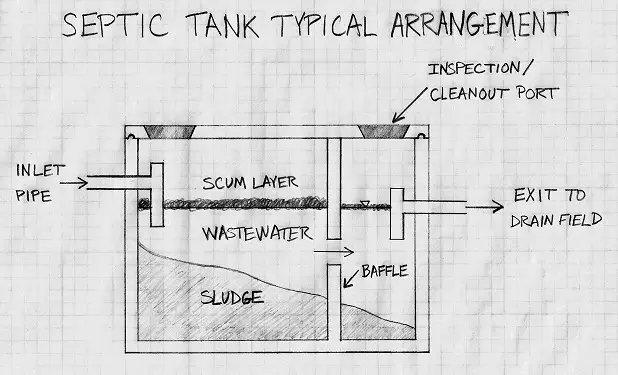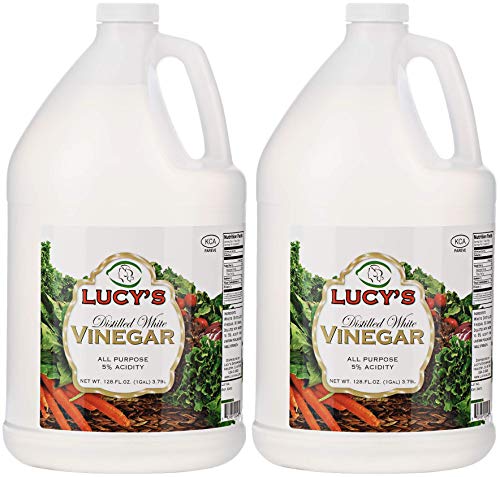To clean out septic tank drain lines can be tricky if you don’t really know what you’re doing. But that won’t be an issue anymore. By the time you’re done with this post, you will know what you’re doing.

It is common knowledge that certain chemicals should not be used to clean septic tanks. However, a lot of people cannot tell which is which.
In today’s pro-tip, we will refer you to safe products you can use to clean out septic tank drain lines and maintain them.
Clogs in your septic tank system can cause it to drain slowly and resulting in pools of water around your yard. It can also cause bad odors around the tank.
We will give you info on how to deal with some of these issues with your drain lines yourself. That way, you can save some money as against calling the professionals.
Table of Contents
Clean Out Septic Tank Drain Lines of Clogs
Clogs are the common issues of drain lines. Its presence can cause water to back up and mess things up. Once you begin to notice slow drains, follow these steps to remove clogs from your drain lines.
- Locate the tank access lid in your yard. It should be close by as it is supposed to be the closest access to your house. Lift the lid which could be plastic or concrete. In some cases, you might have to remove some dirt to access it.
- Inspect the area for a build-up of sludge. You will notice at least two pipes here, a green and a white. If there is a pro-tip at the opening of the pipes, use a long stick to pry it away from the pipe. Ideally, water will start flowing again. If that is the case, then you have removed the clog.
- Use a drain snake. In case water is still not flowing well and the back up in your home is not budging, then the clog might be in the pipe. Insert a drain snake, this one from Ridgid will work great, in the each of the pipes and keep pushing it in. If it encounters an obstruction, that is the clog. Work the drain snake back and forth until you don’t feel the obstruction again. By now, water will start flowing.
- Fill the distribution box with water. This is to test for any remaining clogs. If there are no more and the system is working fine, the water level will remain below the lowest pipe.
- Flush some water back into the pipes. Insert a hose into the pipe and let water through at maximum. This will flush out any remaining dirt from inside the pipe. Replace the lid and you’re done.
How to Use Drain Cleaners for Septic Tank Drain Lines
Drains cleaners come in different forms. Whichever you go for will come down to preference and what you need it for. In this case, we will focus only on the ones you can use for septic tanks. One of the easiest drain cleaners to use is this Drano Septic Treatment. All you have to do is drop a pouch in your toilet and flush. The pouch will dissolve and eat through the clogs in the pipe and breakdown any other waste buildup.
If you’d like a drain cleaner in powder form, this RID-X is what you need. Most septic professionals prefer it for how it works. It introduces natural bacteria and enzymes into your septic systems to digest the waste in there. All you need to do is pour it into your toilet and flush.
How to Maintain Septic Tanks
We certainly hope you don’t experience a septic disaster. Since hope is not enough of a preventive measure, we bring you the following ways you can rely on.
Be efficient with water
Just so you know, the water you use in your home goes into the septic tank. So, the more water you use, the quicker it will fill up. The following are ways you can become more efficient with water usage.
- Efficiency showerheads and faucet aerators. A faucet aerator like this one can help regulate how much water flows out. That way, you can ensure you’re not using more water than you need, hence filling up the septic tank faster. Efficient showerheads like this one too serve the same purpose of managing water usage.
 High-efficiency toilets. Toilets these days have reservoirs that hold less water than they used to. Their flushing technique is more efficient so they don’t need too much water to serve their purpose. We hope those are the types you have installed.
High-efficiency toilets. Toilets these days have reservoirs that hold less water than they used to. Their flushing technique is more efficient so they don’t need too much water to serve their purpose. We hope those are the types you have installed.- Time your laundry. It might seem like a good idea to do all your laundry at once. However, it isn’t so good for its effect on your septic tank because you will be using a lot of water. If you spread your laundry, the tank will have some time to treat its content before you add more to it. Also, try to wash full loads in your machine as against multiple small loads.
The toilet is not a trash can
Anything that goes into your drain, not just the toilets, ends up in the septic tank. As we mentioned earlier, some things are not meant to go in there. Asides the risk of causing a clog, they could also damage the septic tank leading to an expensive and messy disaster.
Only human wastes or toilet paper is allowed to go down your toilet (1). Do not flush:
- Condoms
- Pharmaceuticals
- Female hygiene products
- Grease and oil
- Cigarette butts
- Diapers, etc.
Septic systems contain living organisms and enzymes that break down wastes to keep the tank efficient. Pouring toxins down the drain can kill these organisms and affect how the tank deals with waste.
Be careful what kind of drain openers you use. Be sure to stick with those that will add more digestive enzymes that eat through the clogs and populate the ones already in the septic tank.
The following are some posts to help you clean different parts of your home:
- How to Clean a Sink Overflow
- How to Clean a Microfiber Couch
- How to Dry a Carpet Fast After Cleaning
- How to Clean a Memory Foam Mattress Topper
- How to Clean Pee Out of a Mattress
- How to Clean a Tankless Water Heater
Pump the septic tank routinely
Ideally, you should have professionals inspect your septic tank every 3 years. They should pump it too every 3 to 5 years depending on the size. Those systems with mechanized parts should be inspected more often. On average of every year.
- 1 gallon bottle drain and grease trap cleaning and maintaining solution for commercial environments
- Effectively prevents build-up in grease traps, garbage disposals, drains, sewers
- Powerful formula that wont degrade pipes or damage septic systems
- Does not contain bleach, caustics, or damaging acids
- Summer breeze scent
- The power of microbes and enzymes continuously degrade fats, oils, and greases in drains and grease traps
- Goodbye to rancid kitchen odors by attacking the built up residue commonly found in drains and grease traps
Conclusion
Septic tanks help us manage our waste and we also owe it the responsibility to manage its efficiency. How we do that is to be mindful of what we put into it. Clogs are evidence that we might have been putting the wrong things in our drains. With the methods we have shown, you can now clean out septic tank drain lines with no problems.
It is our hope that you find this information valuable. If so, why not share it with loved ones. They will thank you for it. For more quality information and in-depth reviews, kindly explore our site. Thank you for your time. We hope to serve you in another post.
How to Clean Out Septic Tank Drain Lines — FAQs
How can you know if your drain field is blocked?
Fortunately, there are clear signs to help you know if your drain field is blocked. Once you spot some or all of these signs, be sure to jump to action to prevent an overflow.
- The patch of grass over the drain lines will be greener than other parts of the ground.
- Your plumbing starts to back up and won’t flow freely.
- There will be smells over the yard.
- The ground over the drain field will be mushy and wet compared to other parts.
Once these issues start to show up, you need to give your septic drain line field attention to prevent a full blown chaos.
What type of drain cleaner is safe for septic tank systems?
Not all drain cleaners are safe for your septic tank; some might even worsen the problem over time. Drain cleaners that are safe for your septic tank are the enzymatic ones. They are organic and natural products that won’t damage your plumbing or septic tank. These types might not work as fast as their chemical counterpart but they work and won’t cause any damage to you or your plumbing. Enzyme drain cleaners are the safest types you can use or your septic tank.
To get this enzyme drain cleaner, click here
How can I clean my septic tank naturally?
There are natural products you can use to clean your septic tanks that won’t cause damage to your plumbing. You can mix 1/2 a cup of baking soda with vinegar and 4 table spoons of lemon. The solution will fizz once the baking soda comes in contact with the vinegar. This mixture will dissolve the clog in the pipes and allow the drains to move freely into the septic tank.
Another way is to use enzyme drain cleaners. You simply pour the organic solution into the drain and let it flow into the septic tank while dissolving any clog along its way. This is best practice for maintaining your septic tank as it doesn’t cause any damage.
To get this vinegar, click here
Does hair decompose in a septic tank?
Human and animal hairs does not decompose in septic tanks. As best practice, dispose of hairs in trash cans and not in toilets or sink. Hairs can cause clogs in your filters, drains, septic tanks, and even in the leaching fields. Not treating your toilet or sinks like a garbage can is a good maintenance practice.
Does salt kill bacteria in my septic tank?
Salt does kill bacteria and it will the ones in your septic tank. It might sound like a good idea to kill bacteria, but the ones in your septic tank are there for a good reason. They are responsible for breaking down waste which keeps the septic tank from filling up. You don’t want that to happen because it is expensive to pump out a septic tank.
Can I plant a garden over a septic field?
It is generally acceptable to plant over a septic leach field but, it has to be done with care. Turf grass, ground covers shrubs, herbaceous perennials and annuals are okay to plant over a septic field. However, do not plant a vegetable garden over it as they risk contamination. Root crops can damage the components of the septic tank and cause to lead poisoning. If you must plant vegetables and root crops, make sure to keep 10 feet away from the drain field.


